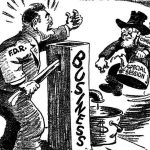The second part of the book follows the developments of macrodynamic models after the first questions on cyclical fluctuations were settled. Major steps in this direction were taken by Tinbergen in the middle of the 1930s, in part as an answer to the results that he uncovered in models with multiple equilibria. Tinbergen’s ideas on the subject were heavily influenced by “literary” economists or associated econometricians such as Irving Fisher and Wilhelm Röpke.
While the usual story focuses on Tinbergen’s estimation of a set of equations while working for the League of Nations, we are not so much interested in this approach—which, for all its originality, was also heavily criticized—but rather by the continuity between the set of equations that Tinbergen confronted to Dutch and American data, and his earlier explorations of the consequences of multiple equilibria on stability and economic policy. This allows us to put in a new perspective the objectives of economic policy: the idea that it should damp out fluctuations is much more potent when the risk behind inaction is a total collapse of the economy!
The chapters in this second part also explore how other economists and econometricians such as Kalecki and Kaldor understood the role of economic policy in macrodynamic models, contrasting it with the early and very developed ideas of Tinbergen. In particular, by going back to Samuelson’s famous multiplier-accelerator model, we show that many ideas on economic policy contained in his two papers published in 1939—ideas that have been often missed—were very close to Tinbergen’s own formulation of the relationship between accelerators and multipliers.
Amidst a new crisis in the United States in the fall of 1937, debates on pump-priming and public interventions thus take a new meaning when viewed through the eyes of economists who began to think, against all training and creed, that those interventions may become a permanent part of economic life: the pill, however hard to swallow, was going to be taken for the rest of times to ensure higher level of income and employment. This found particular support among those, like Alvin Hansen, who began to speak of secular stagnation
 The Amazing Alvin Hansen – Part 2/2 : 1938-1965
The Amazing Alvin Hansen – Part 2/2 : 1938-1965 Out of the beaten path: Lundberg’s take on instability
Out of the beaten path: Lundberg’s take on instability Priming the pump: on some lessons learned from Samuelson’s 1939 accelerator-multiplier model
Priming the pump: on some lessons learned from Samuelson’s 1939 accelerator-multiplier model